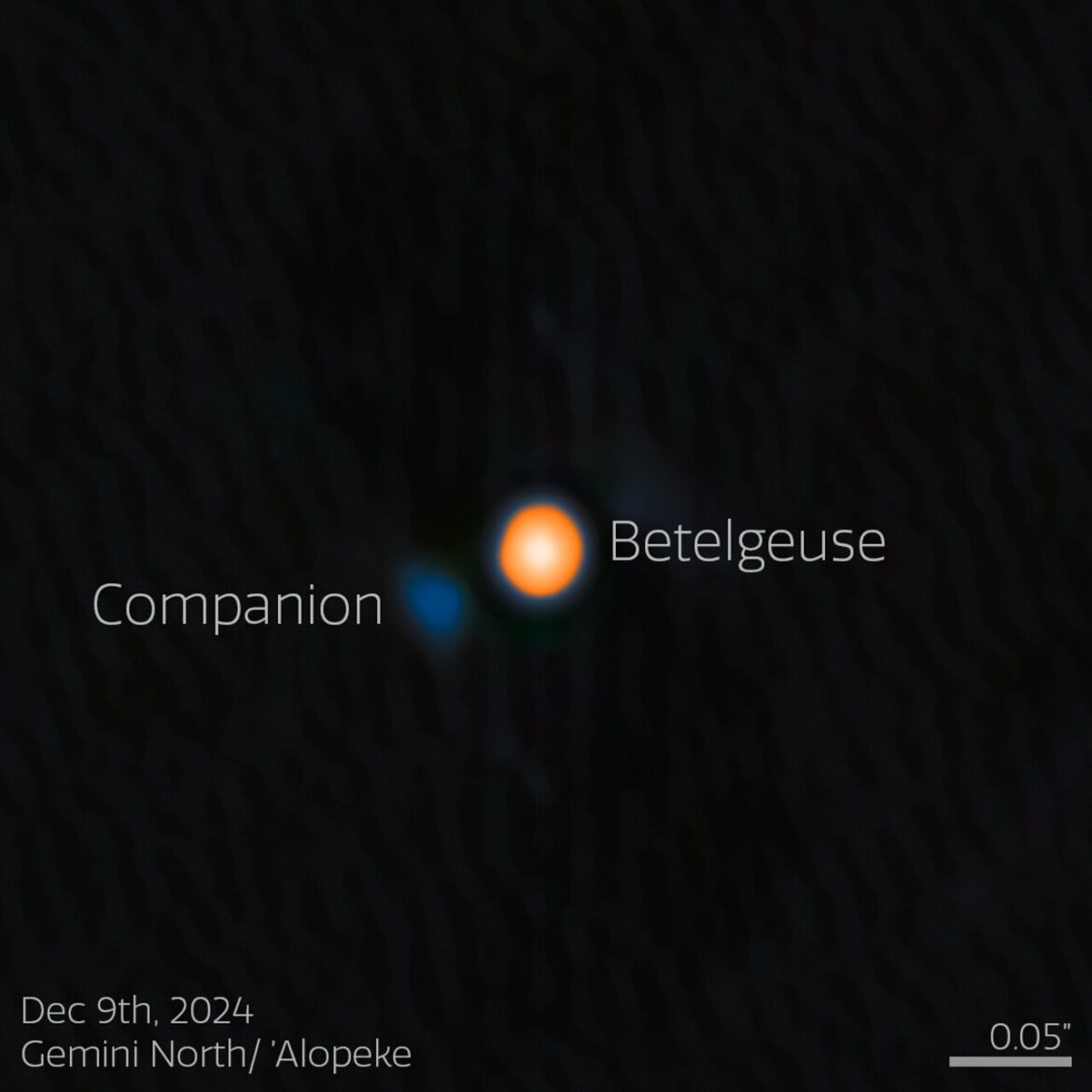Gemini North Discovers Long-Predicted Stellar Companion of Betelgeuse?
Gemini North telescope in Hawai‘i reveals never-before-seen companion to Betelgeuse, solving millennia-old mystery
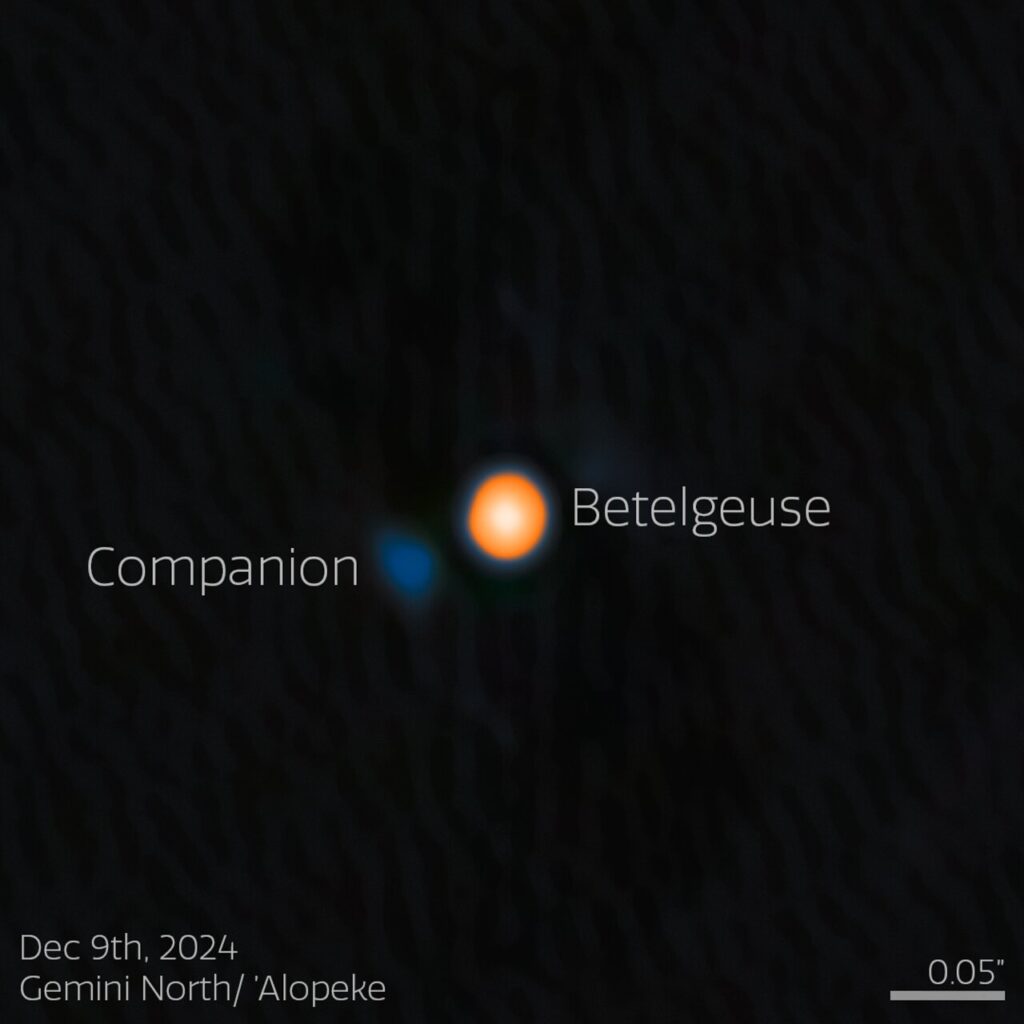
‘Alopeke is funded by the NASA-NSF Exoplanet Observational Research Program (NN-EXPLORE).
Credit: International Gemini Observatory/NOIRLab/NSF/AURA
Image Processing: M. Zamani (NSF NOIRLab)
Please notice that, according to the published studies, Betelgeuse’s companion might not be a star.
Astronomers have discovered a companion star in an incredibly tight orbit around Betelgeuse using the NASA and U.S. National Science Foundation-funded ‘Alopeke instrument on Gemini North, one half of the International Gemini Observatory, partly funded by the NSF and operated by NSF NOIRLab. This discovery answers the longstanding mystery of the star’s varying brightness and provides insight into the physical mechanisms behind other variable red supergiants.

Credit: E. Slawik/NOIRLab/NSF/AURA/M. Zamani
Betelgeuse is one of the brightest stars in the night sky, and the closest red supergiant to Earth. It has an enormous volume, spanning a radius around 700 times that of the Sun. Despite only being ten million years old, which is considered young by astronomy standards, it’s late in its life. Located in the shoulder of the constellation Orion, people have observed Betelgeuse with the naked eye for millennia, noticing that the star changes in brightness over time. Astronomers established that Betelgeuse has a main period of variability of around 400 days and a more extended secondary period of around six years.
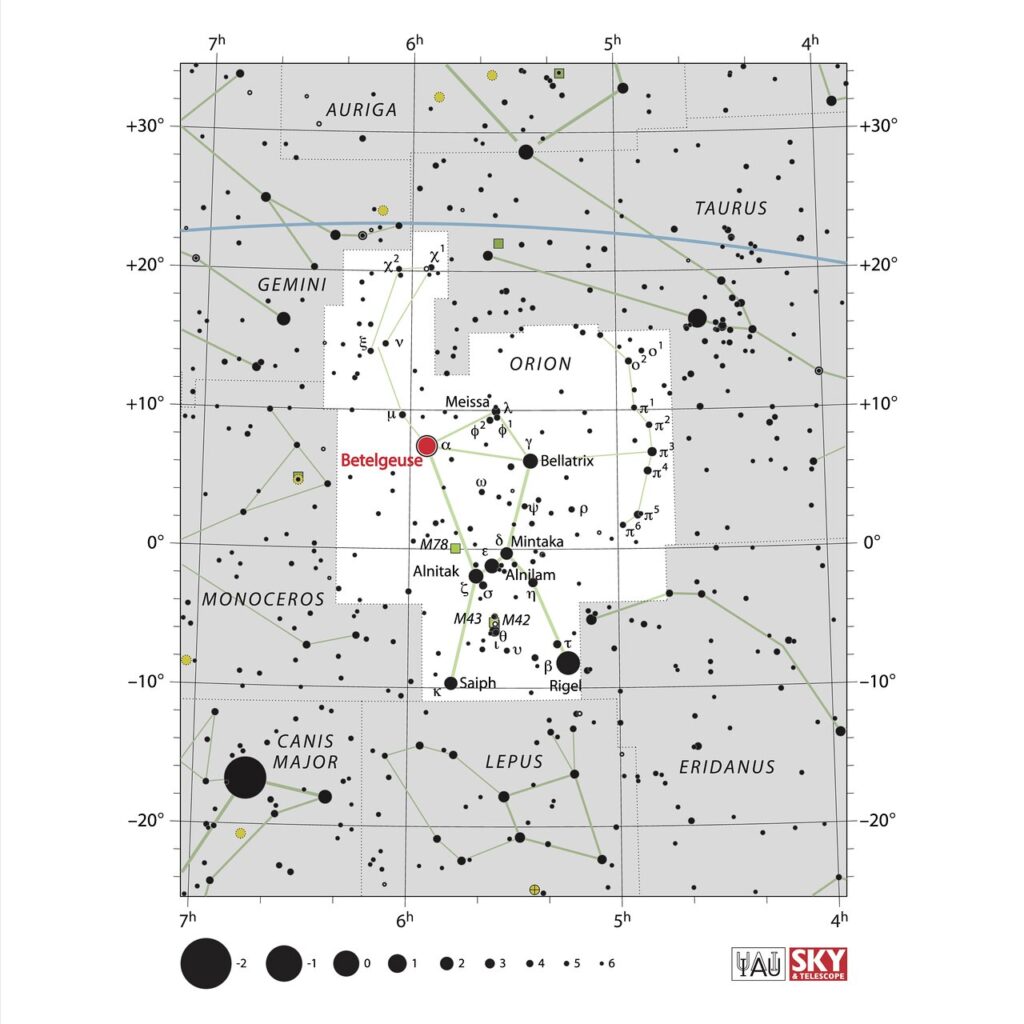
Credit: IAU and Sky & Telescope
In 2019 and 2020, there was a steep decrease in Betelgeuse’s brightness — an event referred to as the ‘Great Dimming.’ The event led some to believe that a supernova death was quickly approaching, but scientists were able to determine the dimming was actually caused by a large cloud of dust ejected from Betelgeuse.
The Great Dimming mystery was solved, but the event sparked a renewed interest in studying Betelgeuse, which brought about new analyses of archival data on the star. One analysis led scientists to propose that the cause of Betelgeuse’s six-year variability is the presence of a companion star [1]. But when the Hubble Space Telescope and the Chandra X-Ray Observatory searched for this companion, no detections were made.
The companion star has now been detected for the first time by a team of astrophysicists led by Steve Howell, a senior research scientist at NASA Ames Research Center. They observed Betelgeuse using a speckle imager called ‘Alopeke. ‘Alopeke, which means ‘fox’ in Hawaiian, is funded by the NASA–NSF Exoplanet Observational Research Program (NN-EXPLORE) and is mounted on the Gemini North telescope, one half of the International Gemini Observatory, funded in part by the U.S. National Science Foundation and operated by NSF NOIRLab.
Speckle imaging is an astronomical imaging technique that uses very short exposure times to freeze out the distortions in images caused by Earth’s atmosphere. This technique enables high resolution, which, when combined with the light collecting power of Gemini North’s 8.1-meter mirror, allowed for Betelgeuse’s faint companion to be directly detected.
Analysis of the companion star’s light allowed Howell and his team to determine the companion star’s characteristics. They found that it is six magnitudes fainter than Betelgeuse in the optical wavelength range, it has an estimated mass of around 1.5 times that of the Sun, and it appears to be an A- or B-type pre-main-sequence star — a hot, young, blue-white star that has not yet initiated hydrogen burning in its core.
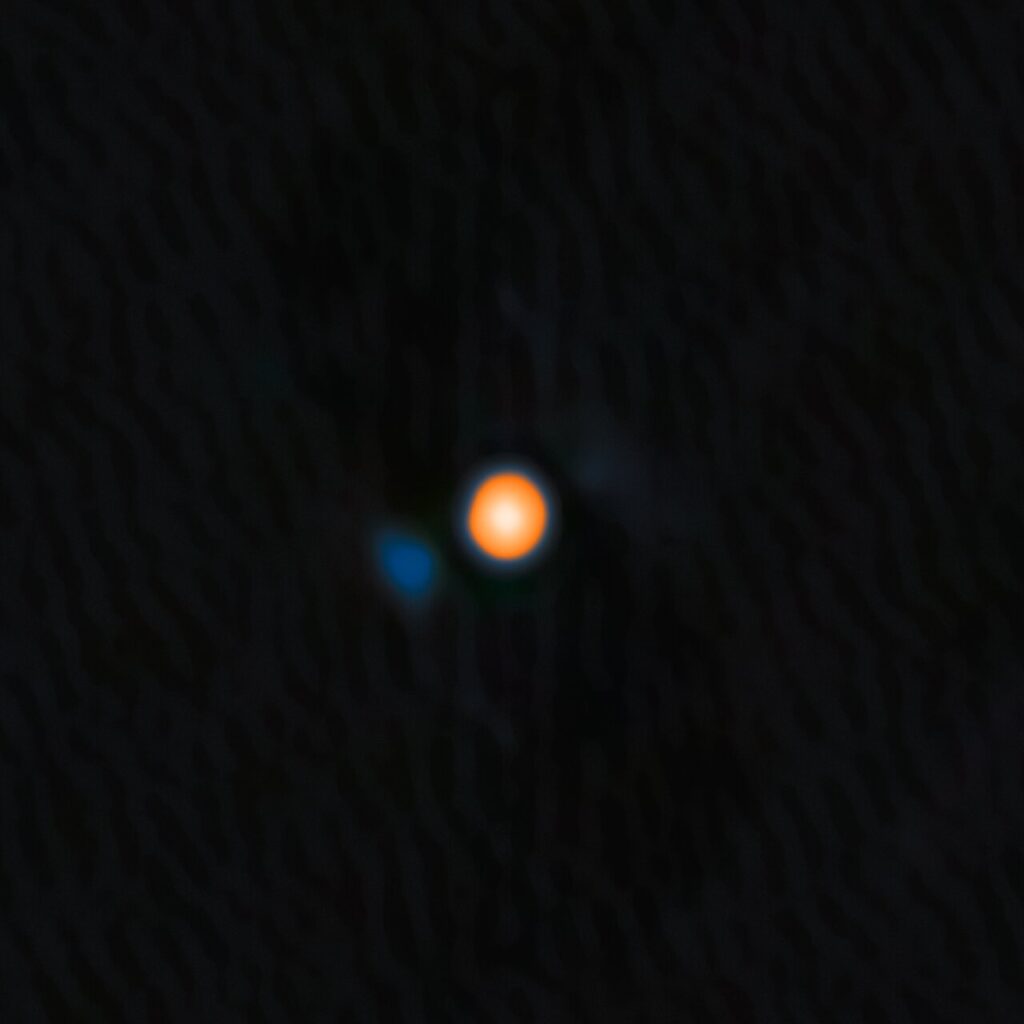
‘Alopeke is funded by the NASA-NSF Exoplanet Observational Research Program (NN-EXPLORE).
Credit: International Gemini Observatory/NOIRLab/NSF/AURA
Image Processing: M. Zamani (NSF NOIRLab)
The companion is at a relatively close distance away from the surface of Betelgeuse — about four times the distance between the Earth and the Sun. This discovery is the first time a close-in stellar companion has been detected orbiting a supergiant star. Even more impressive — the companion orbits well within Betelgeuse’s outer extended atmosphere, proving the incredible resolving abilities of ‘Alopeke.
“Gemini North’s ability to obtain high angular resolutions and sharp contrasts allowed the companion of Betelgeuse to be directly detected,” says Howell. Furthermore, he explains that ‘Alopeke did what no other telescope has done before: “Papers that predicted Betelgeuse’s companion believed that no one would likely ever be able to image it.”
This discovery provides a clearer picture of this red supergiant’s life and future death. Betelgeuse and its companion star were likely born at the same time. However, the companion star will have a shortened lifespan as strong tidal forces will cause it to spiral into Betelgeuse and meet its demise, which scientists estimate will occur within the next 10,000 years.
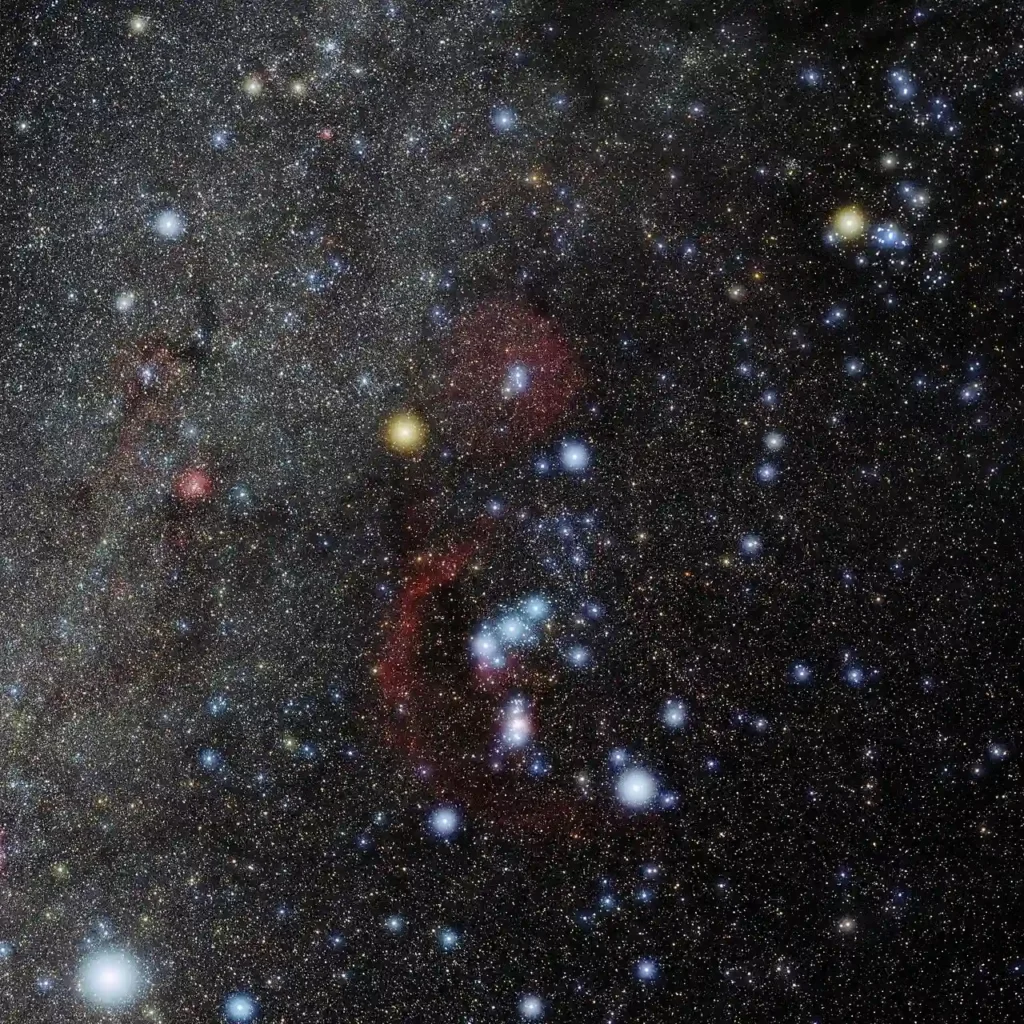
Credit: E. Slawik/NOIRLab/NSF/AURA/M. Zamani
The discovery also helps to explain why similar red supergiant stars might undergo periodic changes in their brightness on the scale of many years. Howell shares his hope for further studies in this area:
“This detection was at the very extremes of what can be accomplished with Gemini in terms of high-angular resolution imaging, and it worked. This now opens the door for other observational pursuits of a similar nature.”
Martin Still, NSF program director for the International Gemini Observatory adds: “The speckle capabilities provided by the International Gemini Observatory continue to be a spectacular tool, open to all astronomers for a wide range of astronomy applications. Delivering the solution to the Betelgeuse problem that has stood for hundreds of years will stand as an evocative highlight achievement.”

‘Alopeke is funded by the NASA-NSF Exoplanet Observational Research Program (NN-EXPLORE).
Credit: International Gemini Observatory/NOIRLab/NSF/AURA
Image Processing: M. Zamani (NSF NOIRLab)
Another opportunity to study Betelgeuse’s stellar companion will occur in November 2027 when it returns to its furthest separation from Betelgeuse, and thus easiest to detect. Howell and his team look forward to observations of Betelgeuse before and during this event to better constrain the nature of the companion.
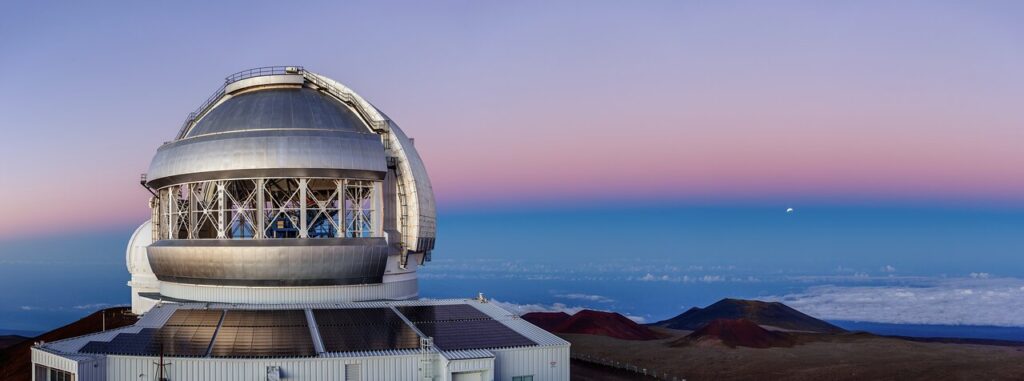
Credit: International Gemini Observatory/NOIRLab/NSF/AURA/J. Chu
Notes
[1] Two papers released in 2024 used decades of observations of Betelgeuse from many observers around the world to predict the orbit and location of the companion star (see DOI: 10.3847/1538-4357/ad93c8 and DOI: 10.3847/1538-4357/ad87f4).
More information
This research is presented in a paper titled “Probable Direct Imaging Discovery of the Stellar Companion to Betelgeuse” to appear in The Astrophysical Journal Letters on 24 July. DOI: 10.3847/2041-8213/adeaaf
The team is composed of Steve B. Howell (NASA Ames Research Center), David R. Ciardi (NASA Exoplanet Science Institute-Caltech/IPAC), Catherine A. Clark (NASA Exoplanet Science Institute-Caltech/IPAC), Douglas A. Hope (Georgia Tech Research Institute, Georgia State University), Colin Littlefield (NASA Ames Research Center, Bay Area Environmental Research Institute), Elise Furlan (NASA Exoplanet Science Institute-Caltech/IPAC).
NSF NOIRLab, the U.S. National Science Foundation center for ground-based optical-infrared astronomy, operates the International Gemini Observatory (a facility of NSF, NRC–Canada, ANID–Chile, MCTIC–Brazil, MINCyT–Argentina, and KASI–Republic of Korea), NSF Kitt Peak National Observatory (KPNO), NSF Cerro Tololo Inter-American Observatory (CTIO), the Community Science and Data Center (CSDC), and NSF–DOE Vera C. Rubin Observatory (in cooperation with DOE’s SLAC National Accelerator Laboratory). It is managed by the Association of Universities for Research in Astronomy (AURA) under a cooperative agreement with NSF and is headquartered in Tucson, Arizona.
The scientific community is honored to have the opportunity to conduct astronomical research on I’oligam Du’ag (Kitt Peak) in Arizona, on Maunakea in Hawai‘i, and on Cerro Tololo and Cerro Pachón in Chile. We recognize and acknowledge the very significant cultural role and reverence of I’oligam Du’ag to the Tohono O’odham Nation, and Maunakea to the Kanaka Maoli (Native Hawaiians) community.
The NASA–NSF Exoplanet Observational Research Program (NN-EXPLORE) is a joint initiative to advance U.S. exoplanet science by providing the community with access to cutting-edge, ground-based observational facilities. Managed by NASA’s Exoplanet Exploration Program (ExEP), NN-EXPLORE supports and enhances the scientific return of space missions such as Kepler, TESS, HST, and JWST by enabling essential follow-up observations from the ground—creating strong synergies between space-based discoveries and ground-based characterization. ExEP is located at the Jet Propulsion Laboratory. More information at https://exoplanets.nasa.gov/exep/NNExplore/overview/.
Press release from NSF NOIRLab.




